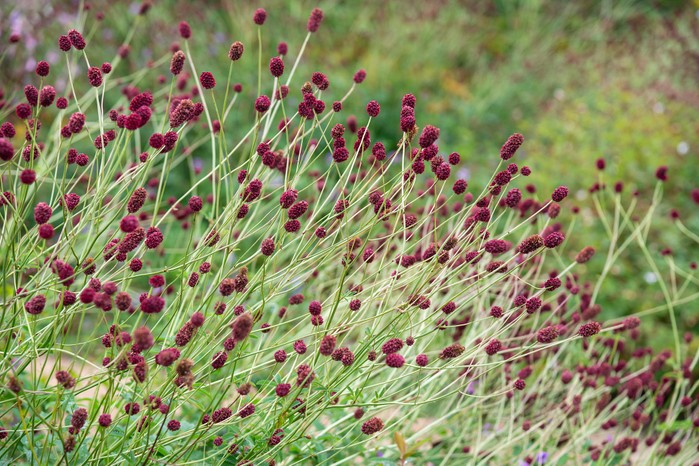
Sanguisorba (burnet) is a hardy herbaceous flowering perennial that has rocketed in popularity over recent years with the rise of naturalistic, prairie-style planting. Blooming in late summer to autumn and attractive in both flowers and foliage, Sanguisorba brings fresh interest to the garden at a time when many plants are finishing for the season. It partners well with ornamental grasses and other naturalistic-looking perennials.
Sanguisorbas bear masses of flowers on slender wiry stems. They vary in shape according to variety, being either fluffy and bottlebrush-shaped, catkin-like or small and bobbly, and come in a range of colours from soft pink and white through to mauve, darker pink, and fashionable dark maroon. Sanguisorba foliage forms clumps of divided leaves usually with serrated edges, that are green or blue-green in colour. The height range of sanguisorbas varies according to variety, from as low as 30cm up to 2m. Most sanguisorbas form neat clumps and are not invasive, although they do tend to self-seed freely.
While not grown for ornamental purposes, the culinary herb salad burnet (Sanguisorba minor) belongs to this group of plants. This low-growing British native is best trimmed regularly to produce a regular supply of young, tender leaves rather than being allowed to flower, although it does make an attractive addition to wildflower meadows.
How to grow Sanguisorba
Grow Sanguisorba in fertile, moist but well-drained soil, in full sun or partial shade. Water well until established. Trim off faded flowers to prevent self-seeding. Cut back dead growth to the ground anytime from autumn to early spring. Propagate by division, in spring.
Where to grow Sanguisorba
Sanguisorba growing en masse in a border
Grow Sanguisorba in sun or partial shade, in good soil that is moisture retentive but drains freely. Once established, Sanguisorba does tolerate spells of dry weather. Grow Sanguisorba as part of a naturalistic, prairie-style, or modern meadow planting as well as to use in more traditional garden borders. Planting in small groups, or repeat planting, both work well. Because Sanguisorba has an airy ‘see through’ habit, there is potential to place taller varieties towards the front of a planting, rather than the typical graduation of short, medium, and tall, from front to back of a border.
How to plant Sanguisorba

Potted salad burnet. Getty Images
Ideally plant Sanguisorba in autumn, during mild spells in winter, or early spring. Only plant in summer if able to keep plants watered for the rest of the growing season. Plant into good soil or improve poor ground before planting by adding organic matter. Firm in thoroughly, water in, and keep watered until established.
How to care for Sanguisorba
Once established, Sanguisorba needs little care apart from cutting back each year. To prevent self-seeding, cut back the faded flower stems before seed ripens. On poorer soils, boost moisture retention by mulching the surrounding soil with garden compost or chipped bark.
Some tall-growing varieties benefit from support, particularly in sites exposed to wind. Ideally, use grow-through supports from spring that quickly become hidden by plant growth. Either buy ready-made supports, construct your own using canes and string or harvest twiggy hazel stems to insert in the ground around the clump.
How to prune Sanguisorba
Cut back dead stems to ground level anytime from autumn to early spring before growth begins.
How to propagate Sanguisorba
Like most herbaceous perennials, Sanguisorba benefits from division every few years as flowering declines on older, congested clumps. Divide clumps from early to mid-spring, using a large knife or sharp spade to cut up the rootball into good-sized chunks. Replant immediately into soil that has been refreshed with well-rotted garden compost or a proprietary soil conditioner, and water well.
Pests and diseases of Sanguisorba
Sanguisorba is generally trouble free once established.
Advice on buying Sanguisorba
- Sanguisorba is available in pots ranging in size from 9cm to 3l. Smaller plants take a year or two to develop into good-sized clumps while the bigger plants give immediate impact
- Sanguisorba varieties vary in height so make sure you choose the right type for the spot you have in mind
- Always check plants for signs of pests and diseases before planting
Where to buy Sanguisorba
Sanguisorba varieties to grow
1
Sanguisorba ‘Tanna’
A compact burnet from Japan, bearing many wine-red blooms above blue-grey foliage from summer to autumn. Height x Spread: 50cm x 40cm
2
Sanguisorba hakusanensis ‘Lilac Squirrel’
Upright stems bear long, fluffy pink-purple flower heads that resemble squirrel tails, from summer to autumn. H x S: 1m x 60cm
3
Sanguisorba officinalis ‘Red Thunder’
Tall flower spikes appear above feathery foliage, making them perfect for naturalistic and prairie-style plantings. H x S: 1.2m x 60cm
4
Sanguisorba canadensis
Grows in damper soils than other burnets, Large, white flowers contrast with hairy, pinnate leaves that take on red hues towards autumn. Ideal for prairie plantings. H x S: 2m x 1m
